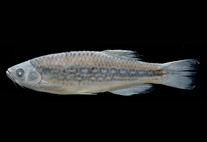Abstract
A new species of Bryconops is described from a right tributary of the lower Tapajós River, State of Pará, Brazil. Bryconops munduruku, sp. nov., differs from its congeners, except B. inpai and B. piracolina, by having a black adipose fin (vs. adipose fin hyaline in alcohol) and, except B. inpai, by possessing two humeral blotches (vs. lack of humeral blotch or only one humeral blotch). Bryconops munduruku differs from B. inpai by having a uniform color pattern on the posterior portion of the side of the body (vs. a dark stripe extending posteriorly from the half of the anal-fin base onto the base of the middle caudal-fin rays). It differs further from B. inpai and B. piracolina by the presence of a black adipose fin that is hyaline along its base (vs. entirely black adipose fin in B. inpai and B. piracolina). The new species is allocated in the subgenus Creatochanes by having a maxillary bone with one to three teeth on both sides, and its posterior extension reaching the junction of second and third infraorbital bones.

